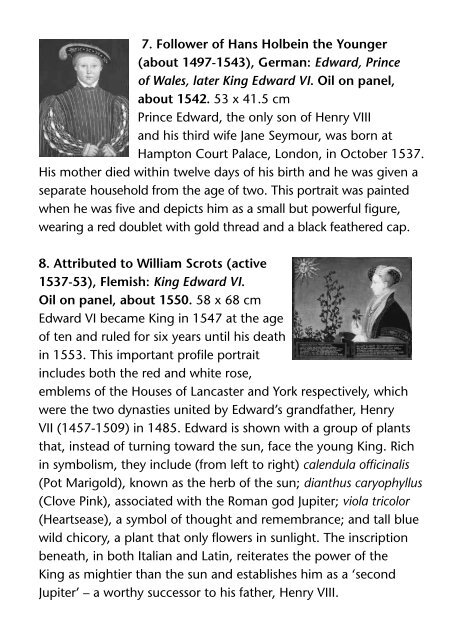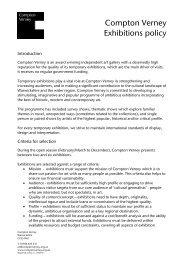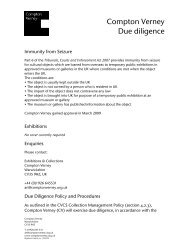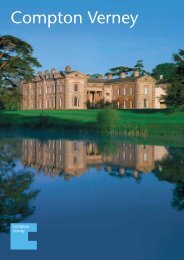Read the gallery guide - Compton Verney
Read the gallery guide - Compton Verney
Read the gallery guide - Compton Verney
You also want an ePaper? Increase the reach of your titles
YUMPU automatically turns print PDFs into web optimized ePapers that Google loves.
7. Follower of Hans Holbein <strong>the</strong> Younger<br />
(about 1497-1543), German: Edward, Prince<br />
of Wales, later King Edward VI. Oil on panel,<br />
about 1542. 53 x 41.5 cm<br />
Prince Edward, <strong>the</strong> only son of Henry VIII<br />
and his third wife Jane Seymour, was born at<br />
Hampton Court Palace, London, in October 1537.<br />
His mo<strong>the</strong>r died within twelve days of his birth and he was given a<br />
separate household from <strong>the</strong> age of two. This portrait was painted<br />
when he was five and depicts him as a small but powerful figure,<br />
wearing a red doublet with gold thread and a black fea<strong>the</strong>red cap.<br />
8. Attributed to William Scrots (active<br />
1537-53), Flemish: King Edward VI.<br />
Oil on panel, about 1550. 58 x 68 cm<br />
Edward VI became King in 1547 at <strong>the</strong> age<br />
of ten and ruled for six years until his death<br />
in 1553. This important profile portrait<br />
includes both <strong>the</strong> red and white rose,<br />
emblems of <strong>the</strong> Houses of Lancaster and York respectively, which<br />
were <strong>the</strong> two dynasties united by Edward’s grandfa<strong>the</strong>r, Henry<br />
VII (1457-1509) in 1485. Edward is shown with a group of plants<br />
that, instead of turning toward <strong>the</strong> sun, face <strong>the</strong> young King. Rich<br />
in symbolism, <strong>the</strong>y include (from left to right) calendula officinalis<br />
(Pot Marigold), known as <strong>the</strong> herb of <strong>the</strong> sun; dianthus caryophyllus<br />
(Clove Pink), associated with <strong>the</strong> Roman god Jupiter; viola tricolor<br />
(Heartsease), a symbol of thought and remembrance; and tall blue<br />
wild chicory, a plant that only flowers in sunlight. The inscription<br />
beneath, in both Italian and Latin, reiterates <strong>the</strong> power of <strong>the</strong><br />
King as mightier than <strong>the</strong> sun and establishes him as a ‘second<br />
Jupiter’ – a worthy successor to his fa<strong>the</strong>r, Henry VIII.<br />
9. After Hans Holbein <strong>the</strong> Younger<br />
(about 1497-1543), German: King Henry VIII.<br />
Oil on panel, about 1560. 98.2 x 72.5 cm<br />
This portrait is a version of <strong>the</strong> last official<br />
portrait painted of Henry VIII (reigned<br />
1509-47). The King employed court painters<br />
to fulfil <strong>the</strong> many demands for his likeness and<br />
used <strong>the</strong>se images as a propaganda tool to<br />
inspire loyalty and devotion in his subjects. Holbein’s original<br />
painting was copied many times, and <strong>the</strong> demand for images of<br />
Henry VIII lasted well beyond his reign. This version dates from<br />
<strong>the</strong> reign of Queen Elizabeth I (reigned 1558-1603) and would<br />
have been designed to assert <strong>the</strong> legitimacy of <strong>the</strong> Protestant<br />
succession.<br />
10. Sir William Beechey R.A. (1753-1839)<br />
British: Mirza Abu’l Hassan Khan. Oil on<br />
canvas, 1809-10. 144.2 x 137.8 cm<br />
Mirza Abu’l Hassan Khan was sent to <strong>the</strong><br />
court of King George III in 1809 by <strong>the</strong><br />
Shah of Persia, to help negotiate a treaty of<br />
alliance between Great Britain and Persia<br />
(Iran). He became a figure of fascination,<br />
and many parties were held in his honour. By this time Beechey<br />
was known as one of <strong>the</strong> foremost portrait painters of his day<br />
and painted two recorded portraits of this sitter. In his diplomatic<br />
diary Abu’l Hassan describes visiting Beechey’s house in Harley<br />
Street and his joy at meeting <strong>the</strong> artist’s children. On arrival back<br />
in Persia in 1811, he was given <strong>the</strong> honorary title of Khan, in<br />
recognition of <strong>the</strong> role he had played in <strong>the</strong> treaty negotiations.
















